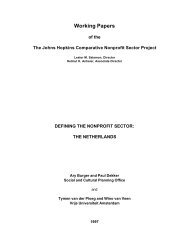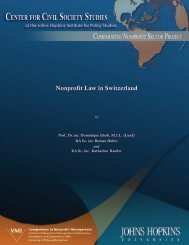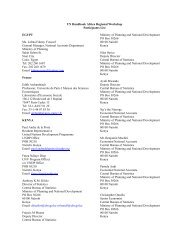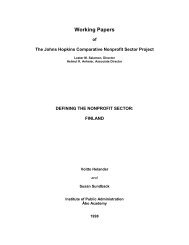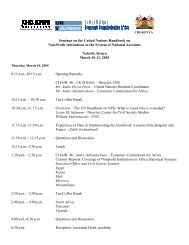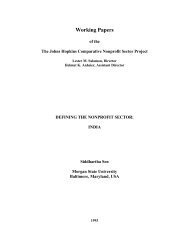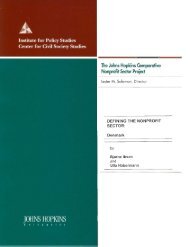Campetella, González Bombal, and Roitter<strong>Defining</strong> <strong>the</strong> <strong>Nonprofit</strong> <strong>Sector</strong>: <strong>Argentina</strong>Political Proscription and Social ConflictsIn 1955 <strong>the</strong> Peronist government was overthrown by a coup d’etat, which was followed by along period of institutional instability. Military interventions, an extreme politicization of <strong>the</strong> wholesociety, and <strong>the</strong> generalization of political violence characterized this period. Peronism wasproscribed, except for a brief period between 1973 and 1976 in which Juan Perón was re-electedpresident. In 1976 <strong>the</strong>re was ano<strong>the</strong>r coup d’etat that initiated <strong>the</strong> bloody dictatorship known as <strong>the</strong>Proceso de Reorganización National (National Reorganization Process).Regarding nonprofit institutions, several of <strong>the</strong>m supported <strong>the</strong> military governments whilesome o<strong>the</strong>rs were havens for <strong>the</strong> political opposition. The unidades básicas seemed to have beenspaces for <strong>the</strong> proscribed Peronism. The Eva Perón Foundation was dissolved immediately after <strong>the</strong>1955 coup d’etat. Trade unions maintained and increased <strong>the</strong>ir power, becoming major pressuregroups. As one result of such power, in 1970 a law was enacted for <strong>the</strong> obras sociales, organizing<strong>the</strong>m into a national system that covered all paid workers.Also, many scientists and intellectuals, who were forced to leave public universities becauseof political persecution, created a large number of research centers and foundations. 9 Several civiland human rights organizations, which later were essential for <strong>the</strong> democratic transition of 1983,were also created in this period.Transition and Consolidation of DemocracySince <strong>the</strong> 1980s, in <strong>the</strong> context of institutional stability and democracy, two processes shouldbe highlighted to understand <strong>the</strong> relationship between <strong>the</strong> state, <strong>the</strong> market, and <strong>the</strong> third sector.First, <strong>the</strong>re has been a greater autonomy of civil society guaranteed by democratic stability andconstitutional liberties. In this sense, civil society has begun to fulfill new functions, such as <strong>the</strong>control of public powers, <strong>the</strong> denouncement of governmental corruption, and <strong>the</strong> promotion of <strong>the</strong>independence of <strong>the</strong> judiciary.Second, since 1989, after <strong>the</strong> economic crisis marked by hyperinflation, profound reforms of<strong>the</strong> economy and <strong>the</strong> state have been undertaken. These processes have brought economic stabilityunder free market conditions, and <strong>the</strong>y also have been <strong>the</strong> cause of <strong>the</strong> state withdrawal from welfarefunctions. Such rolling back of <strong>the</strong> state has opened a space for <strong>the</strong> activity of civil societyorganizations.9In 1958 <strong>the</strong> Institute of Sociology Gino Germani and <strong>the</strong> Di Tella Institute were established. The former was veryimportant in <strong>the</strong> social sciences field, and <strong>the</strong> latter in <strong>the</strong> cultural and artistic fields. (González Bombal y Vacchieri,1986).7
Campetella, González Bombal, and Roitter<strong>Defining</strong> <strong>the</strong> <strong>Nonprofit</strong> <strong>Sector</strong>: <strong>Argentina</strong>On <strong>the</strong> whole, it is possible to conclude that since <strong>the</strong> 1980s <strong>the</strong> third sector has begun to bemore autonomous in <strong>Argentina</strong>. From <strong>the</strong> point of view of society, nonprofit institutions are wellappreciated as <strong>the</strong>y foster <strong>the</strong> re-establishment of linkages of cooperation, solidarity andorganization, and also for <strong>the</strong>ir potential role in social integration. From <strong>the</strong> economic point of viewand taking into account <strong>the</strong> crisis of <strong>the</strong> welfare state, third sector organizations are considered aseffective partners for public policies, owing to <strong>the</strong>ir insertion in <strong>the</strong> community. Fur<strong>the</strong>rmore,economic reforms have prompted a leading role for <strong>the</strong> business sector and, as a consequence, <strong>the</strong>idea of corporate social responsibility has started to circulate in <strong>Argentina</strong>, including civil societyorganizations as recipients of funds or as strategic allies in <strong>the</strong> implementation of communityprograms. From <strong>the</strong> political point of view, third sector organizations are considered as spaces forcitizens’ participation and as devices to monitor public powers. And finally, multilateral institutions–such as <strong>the</strong> World Bank or <strong>the</strong> Inter-American Development Bank– highlight <strong>the</strong> efficient andparticipatory role developed by nonprofit institutions in <strong>the</strong> implementation of social programs. 10Despite <strong>the</strong>se current tendencies, it is still too early to draw definite conclusions, and acareful evaluation of <strong>the</strong> way in which nonprofit institutions will integrate into this new developmentmodel is needed. Bustelo (1996) describes two possible scenarios for this novel relationship between<strong>the</strong> state, <strong>the</strong> market, and <strong>the</strong> civil society:• A “mortal embrace,” meaning that democracy would be suffocated or diminished by amarket- driven society, due to <strong>the</strong> withdrawal of <strong>the</strong> state from its welfare functions and <strong>the</strong>concentration of economic resources. In this scenario, civil society organizations would beinserted into clientelistic relations strongly dependent on <strong>the</strong> government.• A “vital embrace,” meaning that a market-driven society would face <strong>the</strong> concerns broughtabout by democracy, and would promote new social relations based on <strong>the</strong> existence of apublic sphere and <strong>the</strong> full respect of citizenship rights and duties.These and o<strong>the</strong>r scenarios must be subjected to reflection, owing to <strong>the</strong> transitional characterof <strong>the</strong> matrix in which <strong>the</strong> third sector is currently developing in <strong>Argentina</strong>. Consequently, <strong>the</strong>dimension of change is essential for <strong>the</strong> study of this case, since it is situated in <strong>the</strong> context of <strong>the</strong>redefinition of <strong>the</strong> borders among <strong>the</strong> state, <strong>the</strong> market, and <strong>the</strong> civil society.Main Types of <strong>Nonprofit</strong> OrganizationsIt is necessary to clarify certain issues before describing <strong>the</strong> different types of organizationsthat make up <strong>the</strong> nonprofit sector in <strong>Argentina</strong>. The first is related to <strong>the</strong> fact that, in spite of <strong>the</strong>existence of a great variety of organizations, <strong>the</strong>y generally are not aware of “belonging” to a sector,or of being included within a category that defines <strong>the</strong>m and differentiates <strong>the</strong>m from <strong>the</strong> state and<strong>the</strong> business sector. At <strong>the</strong> same time, <strong>the</strong> term “nonprofit sector” is relatively new in <strong>Argentina</strong> and10Among <strong>the</strong> social programs that enjoy financing from multilateral developments banks, we can mention <strong>the</strong> FOPAR(“Participatory Investment Fund”), which includes <strong>the</strong> participation of grassroots organizations in <strong>the</strong> design andimplementation stages of projects and programs. This program, which has been in operation for two years, hasexhibited positive results.8
- Page 1 and 2: Working PapersofThe Johns Hopkins C
- Page 3 and 4: PREFACEThis is one in a series of W
- Page 5 and 6: Campetella, González Bombal, and R
- Page 7 and 8: Campetella, González Bombal, and R
- Page 9: Campetella, González Bombal, and R
- Page 13 and 14: Campetella, González Bombal, and R
- Page 15 and 16: Campetella, González Bombal, and R
- Page 17 and 18: Campetella, González Bombal, and R
- Page 19 and 20: Campetella, González Bombal, and R
- Page 21 and 22: Campetella, González Bombal, and R
- Page 23 and 24: Campetella, González Bombal, and R
- Page 25 and 26: Campetella, González Bombal, and R
- Page 27 and 28: Campetella, González Bombal, and R
- Page 29 and 30: Campetella, González Bombal, and R
- Page 31 and 32: Campetella, González Bombal, and R
- Page 33: Campetella, González Bombal, and R



